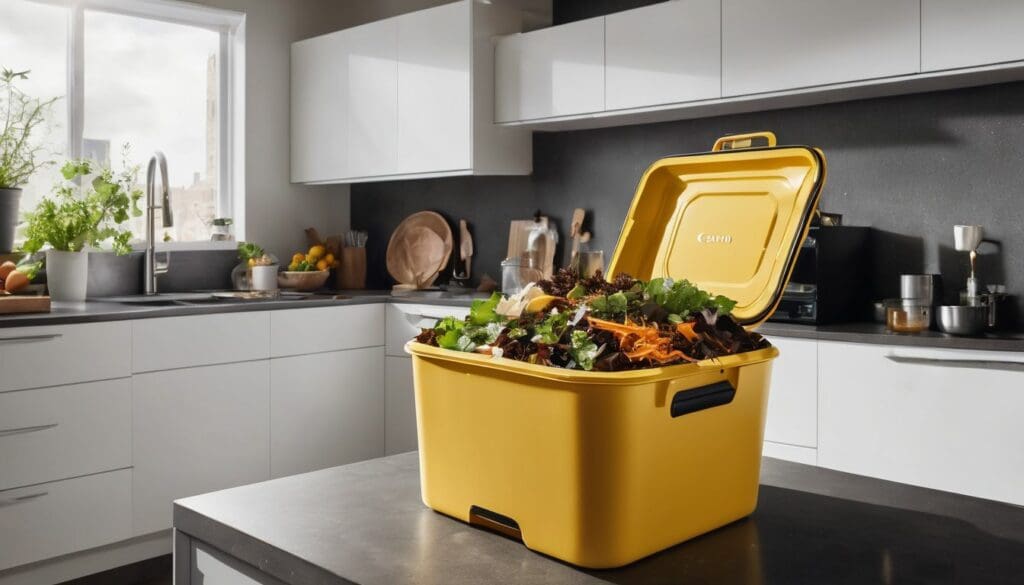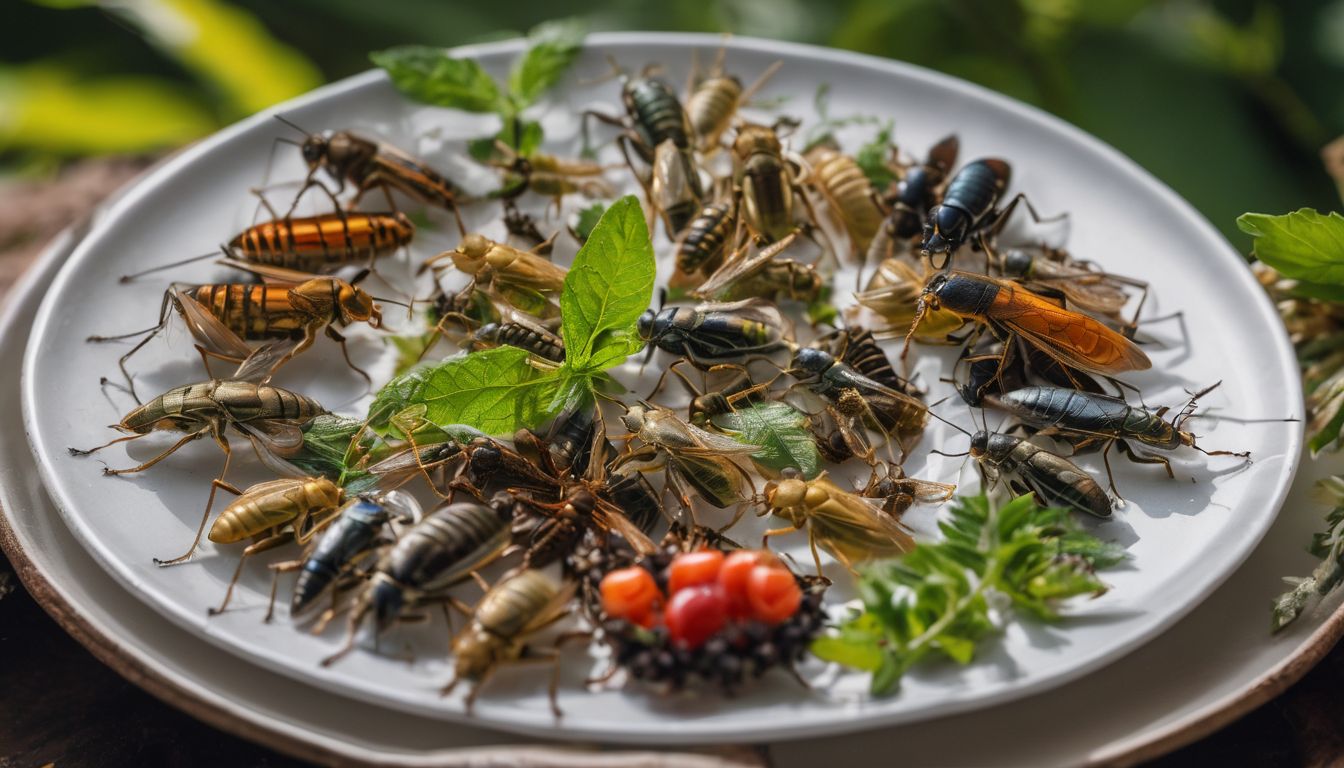Are you tired of seeing good food thrown away? Shockingly, about one-third of all food produced worldwide gets lost or wasted. Our guide offers simple strategies to help you stop this wasteful trend right from your kitchen.
Keep reading – it’s easier than you think!
Key Takeaways
- Methane, a harmful greenhouse gas released during food decomposition, contributes to climate change. Reducing home food waste directly lessens methane emissions.
- Properly storing food extends its shelf life and reduces wastage. Use separate compartments for fruits and vegetables, keep perishables cold, and freeze surpluses.
- Creatively using leftovers can turn them into new meals and save money; for example, stale bread becomes breadcrumbs or croutons.
- Preserving produce through methods like freezing, pickling, or making jams helps prolong their usability whilst avoiding waste.
- Teaching children about the importance of not wasting food encourages sustainable habits from a young age.
The Environmental Impact of Food Waste
Food waste contributes to methane emissions, a potent greenhouse gas that accelerates climate change. Additionally, wasted resources such as water, energy and land are used in the production of food that ultimately goes uneaten.
Methane emissions
Methane emissions are a significant concern when it comes to food waste. This potent greenhouse gas enters the atmosphere as discarded food decomposes, especially in landfills where oxygen levels are low.
Reducing methane emissions is critical for protecting our environment and curbing climate change.
Tackling this problem starts with minimising food wastage at home. By cutting down on the amount of uneaten food, we directly lessen the methane released from rotting leftovers. Every salad scrap or mouldy bread avoided not only saves resources but also contributes to a healthier planet by preventing unnecessary greenhouse gases from entering our air.
Wasted resources
Food waste leads to the squandering of valuable resources such as water, energy, and labor. Wasted food means that the resources used to grow, transport, and process it are also wasted.
This not only impacts the environment but also diminishes the efforts put into producing food in the first place.
When food is thrown away, all the resources that went into its production go to waste. This includes water used for irrigation, energy expended in transportation and refrigeration, as well as human labor involved in planting and harvesting crops or raising livestock.
By reducing food waste at home through mindful consumption and proper storage techniques, we can play a part in conserving these valuable resources for future generations.
The Economic and Social Benefits of Reducing Food Waste
Reducing food waste at home can lead to significant economic benefits, such as saving money on groceries and reducing overall household expenses. Additionally, by minimising food waste, we can help combat hunger and support sustainable practices that benefit the environment and society.
Saving money
By reducing food waste at home, you can save money on groceries and lower your overall food expenses. Planning meals, making a shopping list, storing food properly, and getting creative with leftovers are all practical ways to cut down on wastage, leading to significant cost savings.
Additionally, utilising the whole ingredient and practising portion control will help stretch your budget while promoting sustainability.
To avoid wasting money on excess produce that goes bad before being used up, try preserving it through freezing or pickling. By embracing these strategies for cutting down food wastage at home, you not only contribute to environmental conservation but also benefit financially from reduced household spending.
Reducing hunger
Reducing food waste at home can play a significant role in combating hunger. Every bit of food saved from being thrown away can contribute to alleviating food insecurity for those in need.
Donating excess food to local charities or community organisations is a simple yet impactful way to ensure that edible items don’t go to waste and instead help feed those who are struggling with hunger.
Addressing hunger through reducing food waste not only supports the environment but also creates a positive social impact. By making conscious efforts at home, individuals can take part in a collective movement towards minimising hunger within their communities, ultimately contributing to sustainable solutions on a larger scale.
Promoting sustainable practices
– Reduce food waste by composting leftover scraps to enrich soil and divert waste from landfills, creating a sustainable cycle. Conserve resources by donating excess food to those in need or repurposing it creatively instead of discarding it.
Shop consciously and check expiry dates to minimise unnecessary purchases and wastage.
– Educate children about the importance of reducing food waste, encouraging future generations to adopt sustainable practices early on. Monitor and track your household’s food consumption habits, enabling better management of resources and efficient use of ingredients.
Tips for Reducing Food Waste at Home
Plan meals and make a shopping list to avoid over-purchasing, store food properly to extend its shelf life, get creative with leftovers to minimise waste, preserve excess produce through canning or freezing, use the whole ingredient to reduce scraps, and practise portion control to avoid uneaten food.
Plan meals and make a shopping list
- Prioritise perishable items when planning your meals, so they are used before they spoil.
- Create a detailed shopping list based on your planned meals and check cupboards to avoid buying duplicates.
- Take inventory of what you already have, especially perishable items, before heading out to shop.
- Consider using apps or online platforms that offer digital shopping lists for convenience and easy updates while on the go.
- Stick to your list while shopping, avoiding unnecessary purchases that may lead to food waste.
- Be mindful of portion sizes – it’s better to buy smaller quantities if you’re unsure about consumption.
Store food properly
- Keep perishable items like dairy products, meat, and seafood in the coldest part of the fridge to slow down spoilage and bacterial growth.
- Store fruits and vegetables in separate compartments to prevent them from ripening too quickly due to ethylene gas released by certain produce.
- Use airtight containers or resealable bags to store leftovers or opened packages to maintain freshness and prevent odours from spreading.
- Label leftovers with the date to keep track of their freshness and avoid forgetting about them in the fridge.
- Freeze excess food such as bread, meat, and leftover meals to prolong their shelf life and reduce the chances of them going bad before use.
- Utilise pantry storage wisely by organising items according to expiry dates and visibility for easy access and use.
Get creative with leftovers
Reduce food waste by getting creative with leftovers:
- Transform leftover vegetables into a flavourful soup or stew by adding broth and seasoning.
- Use stale bread to make croutons, breadcrumbs, or a delicious bread pudding.
- Repurpose cooked grains such as rice or quinoa into hearty salads or casseroles.
- Turn leftover roasted meats into sandwiches, wraps, or stir-fries for quick and tasty meals.
- Combine various leftovers to create new dishes, like using leftover vegetables and proteins in a frittata or omelette.
- Make use of overripe fruits by blending them into smoothies, baking them into muffins, or making fruit compote for topping desserts.
- Freeze any excess portions for future use in convenient ready-to-eat meals or as a base for soups and sauces.
- Use leftover herbs to make herb – infused oils for cooking or salad dressings to add extra flavour to your dishes.
- Incorporate leftover cooked pasta into salads, soups, or sautés for a satisfying meal without wasting food.
- Repurpose leftovers creatively to reduce food waste while enjoying delicious meals and snacks at home.
Preserve excess produce
Once you’ve purchased or grown your produce, it’s essential to ensure its longevity to prevent wastage. Here’s how to preserve excess produce:
- Store fruits and vegetables separately: Fruits release ethylene gas, which can speed up the ripening of some vegetables. Therefore, it’s essential to store them separately.
- Freeze fruits and vegetables: Many fruits and vegetables can be frozen for later use, such as berries, bananas for smoothies, and vegetables for soups or stews.
- Make jams or pickles: Homemade jams and pickles are a great way to preserve excess fruit and vegetables whilst adding variety to your pantry.
- Dehydrate produce: Using a dehydrator or oven at a low temperature allows you to preserve excess fruits and vegetables by removing moisture.
- Canning: Invest in canning jars and learn the art of preserving excess produce through canning methods such as water bath canning or pressure canning.
- Fermenting: Explore the world of fermentation with excess produce like cabbage for sauerkraut, cucumbers for pickles, or kimchi using various vegetables.
- Share with friends and family: If you have an abundance of produce that you cannot handle yourself, share it with friends, neighbours, or community members who will appreciate it.
Use the whole ingredient
When you’ve preserved your excess produce, the next step is to make the most of each ingredient you have. Here are some practical tips for using the whole ingredient:
- Embrace root-to-stem cooking by utilising vegetable peels and scraps in stocks and soups.
- Incorporate citrus zest into dishes to add flavour and reduce waste from fruit peels.
- Repurpose leftover bread into croutons or breadcrumbs for salads or toppings.
- Utilise meat bones and seafood shells to make flavourful broths and sauces.
- Transform overripe fruits into smoothies, sauces, or baked goods to minimise spoilage.
Portion control
To further reduce food waste at home, another effective strategy is portion control. By managing portion sizes, you can minimise leftovers and ensure that the food you prepare is consumed. Here are practical tips for implementing portion control:
- Serve smaller portions: Use smaller plates and bowls to help control portion sizes without sacrificing satisfaction.
- Measure ingredients: Use measuring cups and spoons to accurately portion out food while cooking or preparing meals.
- Avoid overfilling: Resist the temptation to heap large portions onto plates, which can lead to uneaten food.
- Share meals: Consider sharing larger dishes with family or friends to avoid overeating and reduce excess food.
Additional Ways to Conserve Food Resources at Home
Donate excess food to local food banks and charities, compost food scraps, reuse packaging, shop consciously by checking expiry dates, educate children on the importance of reducing food waste, and monitor and track your household’s waste.
Learn more about the various ways you can minimise food wastage at home by reading the full blog post!
Donate to food banks
Contribute to food banks as a way to reduce food waste and support those in need. Many people struggle with food insecurity, so donating excess non-perishable items or unspoiled produce can make a significant difference.
By doing this, you help ensure that edible food is used rather than wasted.
Support your local community by giving back through donations to food banks. Every little bit helps, and together we can work towards minimising food waste while providing assistance to those who require it the most.
Compost food scraps
“Compost food scraps in a small outdoor bin or indoor container to reduce waste and create nutrient-rich soil for your garden. Mix greens like fruit and veggie scraps with browns such as coffee grounds, paper, or dried leaves.
Turn the compost regularly to aerate and speed up decomposition, ensuring adequate moisture levels throughout the process.”.
“For flat dwellers, consider using a worm composting system. Simply add worms to a shallow tray filled with bedding material and food scraps, then let them work their magic. The end result is vermicompost – an excellent fertiliser for houseplants! Composting not only reduces methane emissions from landfills but also cuts down on household rubbish that goes into bins destined for incinerators or dumps.”.
Reuse packaging
When storing leftover food, consider reusing packaging such as glass jars, plastic containers, or foil to extend the shelf life of items. By repurposing these materials instead of throwing them away, you can help reduce waste while keeping your food fresh for longer periods.
Get into the habit of washing and properly drying these containers once they are empty to ensure that they remain clean and safe for future use. This simple practice not only reduces your environmental footprint but also saves money that would have been spent on purchasing additional storage solutions.
Additionally, when shopping for groceries, opt for products that come in reusable or recyclable packaging. Doing so will contribute to minimising unnecessary waste and support sustainable practices within your household.
Shop consciously and check expiration dates
To reduce food waste, shop consciously by checking expiry dates on food products. When shopping, ensure to select items with the longest expiry dates to minimise the chance of wastage. Here are some practical tips for reducing food waste through conscious shopping:
- Avoid impulse buys and stick to your shopping list to prevent buying more than needed.
- Check expiry dates before purchasing perishable items like dairy, meats, and produce.
- Be mindful of “best before” dates and understand the difference between “use by” and “sell by” dates.
- Rotate older items to the front of the fridge or pantry so they’re used first.
Educate children
Teaching children about the importance of reducing food waste instills lifelong habits. Educating children through fun activities and lessons can help them understand the value of food and the impact of wasting it on the environment and society.
By involving children in meal planning, portion control, and cooking, they become more mindful of how much food is needed and learn creative ways to use leftovers. Encouraging them to appreciate where food comes from can also lead to a deeper understanding of its value, leading to less wastage overall.
Empower your kids with knowledge about sustainable practices for a brighter future by making it engaging and relatable for their age group.
Monitor and track waste
Educating children about food waste sets a great foundation for monitoring and tracking waste in the household. Here are some practical ways to monitor and track food waste:
- Keep a food waste diary to document what is being thrown away and why, allowing for adjustments to be made.
- Utilise technology such as apps or spreadsheets to record and analyse food waste patterns.
- Regularly take stock of the fridge and pantry to use items before they spoil.
- Implement a system to rotate older items to the front while placing newer items at the back.
- Conduct regular waste audits to identify areas where improvements can be made.
- Set specific goals for reducing food waste and regularly measure progress towards those goals.
Conclusion
In summary, reducing food waste at home is crucial for protecting the environment and conserving resources. By implementing simple strategies such as meal planning, proper storage, and creative use of leftovers, individuals can make a significant impact.
Additionally, supporting initiatives like donating to food banks and composting food scraps helps in minimising waste and addressing hunger issues. Taking these practical steps not only benefits the environment but also promotes sustainable living and responsible consumption habits.
FAQs
1. What are some effective ways to reduce food waste at home?
You can cut down on food wastage by planning meals, storing food correctly, and using leftovers creatively.
2. Can you give practical tips for minimising food wastage in the kitchen?
Certainly! Always shop with a list to avoid overbuying, understand expiry dates properly, and implement strategies like first-in-first-out to use older items first.
3. How can creative methods help in preventing food waste?
Creative methods include repurposing scraps into broths or composting them, along with preparing portions according to individual needs to prevent excess.
4. Are there techniques I can learn for reducing food wastage while cooking?
Yes, techniques such as measuring ingredients accurately and adapting recipes based on what you already have available are great ways to avoid excess.
5. What advice do you have for someone who wants to start limiting their food waste today?
Start by taking small steps such as keeping an eye on what’s in your fridge, freezing surplus produce, and sharing extra meals with neighbours or friends.





